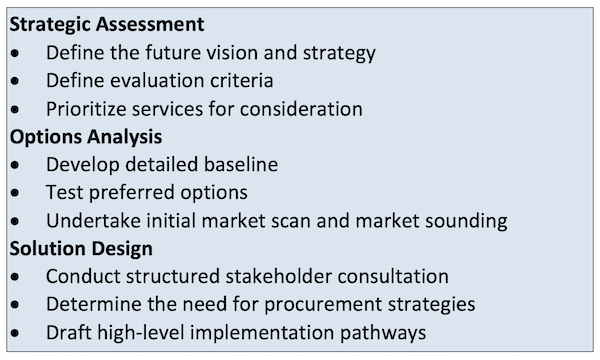Whether you’re trying to decide on which brand of cereal to buy, a holiday destination, or having your in-laws for dinner, making the wrong decision can be paralyzing. The same can be said when selecting which alternative service delivery (ASD) model to implement.
Many believe ASD is a natural product of New Public Management reforms that swept the world in the 1980s. Others say it was the answer to the complex question of how to address fiscal pressures and service modernization while protecting the public interest.
For example, Ontario’s 1999 ASD guidelines state: “Among the goals that the Ontario Government has set for itself are: to provide quality service to the public, focus on core business, decrease spending, balance the budget, eliminate barriers to business and create a prosperous economy. To achieve these goals, the Ontario Public Service has begun to make fundamental changes in the way it works.”
The driving force for any infrastructure project lies in the services enabled, whether clean water, education, healthcare, or transportation. As the scale and scope of such projects respond to the type and quality of public services required, delivery models must adapt. In Canada, the procurement vehicle of choice is public-private partnerships (P3).
Canada is known for its pioneering spirit in the P3 market. Community-based public opinion polls show positive support for P3 projects. But no one suggests that P3s are a panacea. It is prudent for project sponsors and their teams to exercise a duty of care in assessing all feasible service delivery models before making decisions.
Eeny, meeny, miny, moe
Traditional infrastructure projects are managed from conception to completion by the public service. This means that the core essential services of projects are predominantly in-house.
Outsourcing or contracting out occurs when government decides to transfer functions or activities to contractors for specific periods of time. Regardless, government retains responsibility and is held to account in public for project results. Outsourcing can be advantageous, provided there are qualified suppliers available to complete the required tasks according to the specifications outlined.
P3s have features that are distinct from those of traditional and outsourcing options. The ability to share risk with partners is one of the most appealing factors to government agencies. Access to management or professional expertise not available within government is another. Financing has proven over time to be a lesser consideration in forging P3s, as many governments can borrow money cheaper than private partners.
Building successful ASDs
After selecting a model, it may be difficult for proponents to test the hypothesis. A detailed, properly-prepared contract is an asset in minimizing scope and scale changes. Assembling a team of qualified advisors to defend greater interests is equally important. Surrounding oneself with “yes people” can have devastating and embarrassing consequences.
KPMG’s Transforming Government is a proven approach that outlines key project management, stakeholder engagement, and governance strategies that should be considered by proponents.

ASD models can be powerful tools in building much-needed or upgrading aging infrastructure. They can also bring a wide range of benefits, including capital, expertise, efficiencies, innovation, and risk protection. But government officials must first assess systematically which service delivery models are feasible for their project and whether the preferred model is appropriate – fit for purpose and viable.
Construction Dive reporter, Kim Slowey, highlights five SMART implementation considerations:
- Pick the right model;
- Build a solid team;
- Advocate for transparency;
- Solicit public approval; and
- Find a champion.
When it comes to ASD models, there is no one-size-fits-all approach. Each model has its own strengths and weaknesses relative to the project context. Project management principles – initiating, planning, executing, monitoring and controlling, project closure – underpin successful projects.
ASD projects inevitably run into a few bumps along the way. Nothing is perfect. The key is to learn from mistakes and keep pursuing better service that costs less.
